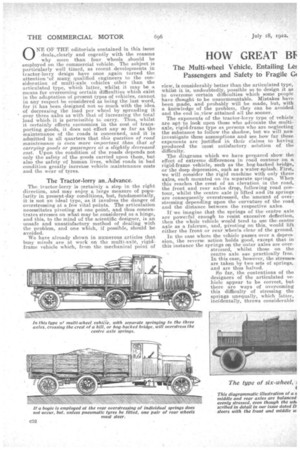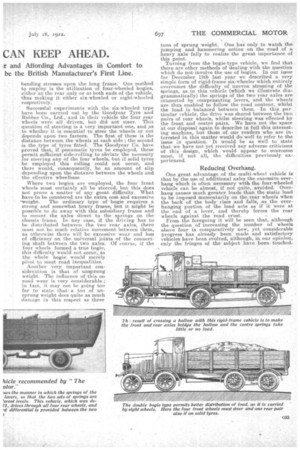HOW GREAT BF CAN KEEP AHEAD.
Page 16

Page 17

If you've noticed an error in this article please click here to report it so we can fix it.
The Multi-wheel Vehicle, Entailing Le: Passengers and Safety to Fragile GI and Affording Advantages Ili Comfort to be the British Manufacturer's First Line.
NE OF THE editorials contained in this issue , deals,olearly and cogently with the reasons why more than four wheels should be employed on the comniercial vehicle. The subject is particularly well timed, as recent developments in tractor-lorry design have once again turned the attention of many, qualified engineers to the consideration of multi-axle vehicles other than the articulated type, which latter, whilst it may be a means for overcoming certain difficulties which exist in the adaptation of present types of vehicles, cannot in any respect be considered as being the last word, for it has been designed not so much with the idea of decreasing the load per wheel by spreading it over three axles as with that of increasing the total load which. it is perinissible to carry. Thus, whilst it certainly effects economies in the cost of transporting goods, it does not effect any so far as the maintenance of the roads is concerned, and it is admitted in all quarters that this question of road maintenance is even more important than that of carrying goods or passengers at a slightly decreased cost. Upon the condition of the roads depends not only the safety of the goods carried upon them, but also the safety of human lives, whilst roads in bad condition greatly increase vehicle maintenance costs and the wear of tyres,
The Tractor-lorry an.. Advance.
The tractor-lorry is certainly a step in the right direction, and may enjoy a large measure of popularity in present-day conditions, but, fundamentally, it is not an ideal type, as it involves the danger of overstressing at a few vital points. The articulation necessitates pivoting at one point, and thus concentrates stresses on what may be considered as a hinge, and this, to the mind of the scientific designer, is an unsafe and unsatisfactory method of dealing with the problem, and one which, if possible, should be avoided.
We have already shown in numerous articles that busy minds are at work on the multi-axle, rigidframe vehicle which, from the mechanical point of view, is considerably better than the articulated type, whilst it is, undoubtedly, possible so to design it as to overcome certain difficulties which some people have 'thought to be unsurmountable. Mistakes have been made, and probably will be made, but, with a knowledge of the problem, they can be avoided and the end in view attained all the sooner.
The exponents of the tractor-lorry type of vehicle are t.to look upon those who advocate the multiaxle, rigid-frame type as persons who are neglecting the substance to follow the shadow, but we will now investigate these assumptions and see how far these exponents are justified in their claims to having produced the most satisfactory solution of the difficulty.
The diagrams which we have prepared show the effect of extreme differences in road contour on n, rigid-frame vehicle, such as the hog-backed bridge, or the deep depression, such as a water-splash. First, we will consider the rigid machine with only three axles, each mounted on its separate springs. When this reaches the crest of an elevation in the road, the front and rear axles drop, following road contour, whilst the centre axle is lifted and its springs are consequently overstressed, the 'amount of overstressing depending upon the curvature of the road and the distance between the respective axles.
If we imagine that the springs of the centre axle are powerful enough to resist excessive deflection, then the whole vehicle would tend to use the centre axle as a fulcrum, and, pivoting on this, would lift either the front or roar wheels clear of the ground.
In the case where the vehicle passes over a depression' the reverse action holds good, except that in this instance the springs on the outer axles are overstressed, whilst those on the centre axle are practically free. In this case' however, the stressesare taken by two sets of springs, and are thus halved.
So far, the contentions of the designers of the articulated vehicle appear to be correct, but there are ways of overcoming this difficulty of stressing the springs unequally, which ratter, incidentally, throws considerable bending stresses upon the long frame. One method to employ is the utilization of four-wheeled bogies, either at the rear only or at both ends of the vehicle, thus making it either six-wheeled or eight-wheeled respectively.
Successful experiments with the six-wheeled type have been carried out by the Goodyear Tyre and Rubber Co., Ltd., and in their vehicle the four rear wheels were all driven, but did not steer. This question of steering is a very important one, and as to Whether it is essential to steer the wheels or eot depends upon two factors. The first of these is the distance between the wheels at each side ; the second is the type of tyres fitted. The Goodyear Co. have proved that, if pneumatic tyres be employed, these permit sufficient side-rolling to obviate the necessity tor steering any of the four wheels, but if solid tyres be employed this rolling could not occur, and there would, consequently, be an amount of slip depending upon the distance between the wheels and • the effective wheelbase.
• Where two bogies are employed, the four front wheels must certainly all be steered, but this does not prove a matter of any great difficulty. What have to be countered are the extra cost and excessive
..-weight. The ordinary type of bogie requires a strong and somewhat heavy frame, but it might be possible to do away with this subsidiary frame and to mount the axles direct to the springs on the chassis frame. In any case, if the driving has to be distributed between the two rear axles, there must not be much relative movement between them, as otherwise there will be excessive wear and loss of efficiency on the universal joints of the connecting shaft between the two axles. Of course, if the four wheels formed a true bogie, this difficulty would not occur, as the whole bogie would merely Pivot to meet road inequalities.
Another very important consideration is that of unsprung weight. The influence of this on road wear is very considerable ; in fact, it may not be going too far to state that a ton of unsprung weight does quite as much damage in this respect as three tons of sprung weight. One has only to watch the jumping and hammering action on theroad of a heavy axle fully to realize the great importance of this point.
Turning from the bogie-type vehicle, we find that. there are other methods of dealing with the question which do not involve the use of bogies. In our issue for December 13th last year we described a very simple form of rigid-frame six-wheeler which entirely overcomes the difficulty of uneven stressing of the springs, as in this vehicle (which we illustrate diagrammatically) the springs of the two roar axles are connected by compensating levers, and the wheels are thus enabled to follow the road contour, whilst the load is balanced between them. In this particular vehicle, the drive was shared between the two pairs of rear wheels, whilst steering was effected bY the front and centre pairs. We have not the space -at our disposal again to describe in full this interesting machine, but those of our readers who are interested in this matter would do well to refer to the issue in question. It would be as well to state that we have not yet received any adverse criticisms of this design, which would appear to overcome most, if not all, the difficulties previously experienced.
Reducing Overhang.
One great advantage of the multi-wheel vehicle is that by the use of additional axles the excessive overhang which is often necessary with the four-wheeled vehicle can be almost, if not quite, avoided. Overhang causes much greater loads than the static load to be imposed momentarily on the rear wheels when the back of the body rises and falls, as the overhanging portion of the load acts as if it were at the end of a lever, and thereby forces the rear wheels against the road crust.
From the foregoing it will be seen that, although the question of 'increasing the number of wheels above four is comparatively new, yet considerable progress has already been made and satisfactory vehicles have been evolved, although, in our opinion, only the fringes of the subject have been touched.
































